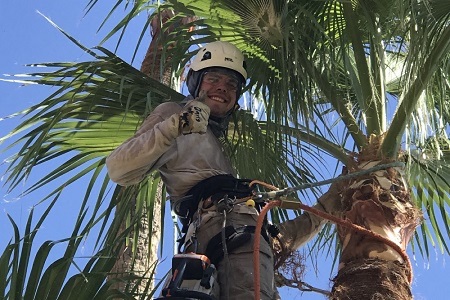In 1923, Robert Frost penned the opening words to “Nothing Gold Can Stay,” remarking on the changing of the seasons and how “nature’s first green is gold.” Like the namesake poem by Robert Frost, palm trees in Paradise Valley are often seen as a symbol of nature’s bounty. Their deep green fronds, luckily, are unaffected by the changing of the seasons.
However, like other living things in nature, palm trees can fall prey to diseases due to infection or genetic predispositions. Without preventive action, emergency tree removal becomes inevitable. Luckily, PV Trimmers is here with a guide to identifying common palm tree diseases.
In this blog, we will explore some of these common palm tree maladies so you can recognize their signs early, prevent damage and avoid pricy palm tree removal costs.

Common Diseases for Palm Trees
Common palm tree diseases are usually fungal in nature and can attack the buds, roots and palms, so it is important to note issues on each part of the tree rather than focusing on a single frond for proper tree care. Be sure to use a step ladder and then call the professional tree services at PV Trimmers instead of attempting to cure or remove a dead tree yourself. Palm trees are very sensitive creatures for all their evergreen splendor, and with our expert hands, you can avoid having to pay for tree removal in Phoenix.
Leaf Spots and Leaf Blights
Leaf spots and blights are fungi that affect the leaves of the palm tree. Leaf spots show up in spores, circular to elongated, brown, and possibly oily in appearance. This can cause discoloration or even holes in the fronds. These spores are spread by water and can quickly infect a large area of trees, causing premature yellowing or wilting of fronds. Thankfully, leaf spots are one of the more benign diseases and can be treated with a simple copper-based fungicide.
Diamond Scale
Diamond Scale is a particular form of leaf spots. It’s also a common palm tree disease caused by the fungus, Phaeochoropsis neowashingtoniae. The fungus will cause yellowing and wilting of the fronds, and can be identified by small diamond-shaped lesions on the leaves. These lesions are usually white or gray in color with a reddish edge. Treatment is the same as with any leaf spot disease: copper fungicide.
Fusarium Wilt
Fusarium Wilt is a fungal disease that affects the roots of date palms and fan palms and can lead to their death. This pathogen thrives in wet soils and can quickly spread from one palm tree to another, causing premature wilting or yellowing of fronds. Fusarium Wilt is generally diagnosed by the yellowing of the fronds and wilting of the tree in a V-shape pattern.
It is important to inspect palm trees regularly and to water only when needed because this disease will kill palm trees quickly. Copper fungicide is recommended to prevent the spread of further infection, and our expert palm tree removal service in Phoenix can quickly and safely remove the tree if needed.
Bud Rot

Bud Rot is caused by a species of fungal pathogens known as Phytophthora and Thielaviopsis, which can quickly spread from one tree to the next and affect an entire grove. Early signs of the infection include black lesions on young buds and wilting leaves. Before long, a slimy rot develops in the bud before further damage is caused by secondary invaders.
Early detection is key – look for sudden discoloration of fronds or black ooze on the tree. Treating bud rot requires digging up and destroying infected plants, as well as preventative treatments such as proper fertilization and irrigation practices. Because of the intensive process required to remove bud rot, it’s recommended to call an arborist specialized in palm trees rather than handle it yourself.
Ganoderma Root & Butt Rot
Ganoderma butt rot is another fungal disease that affects the trunk of the palm tree. This disease can lead to death, as well as an inability for the tree to absorb water and nutrients. Symptoms of Ganoderma butt rot may include discoloration or splitting of the bark near the base of the tree, white fungus growing or around the trunk, and sometimes a strong odor.
To prevent this disease, it is important to inspect the palm trees for signs of infection after intense rain. Flash rainstorms can often create conditions favorable for these fungal diseases to spread, and proper irrigation and drainage make prevention all the easier.
Need Palm Tree Services in Phoenix? Look No Further
Palm tree diseases, while frustrating to detect and manage, are not an uncommon occurrence in Paradise Valley. For more information on palm tree health issues to look out for, the University of Florida provides a comprehensive index for all of the common diseases and deficiencies that can affect them.
With a bit of vigilance and the help of PV Trimmers, you can identify common palm tree diseases early on, prevent damage and avoid costly palm tree removal in Phoenix. Contact us at (602) 887-9391 for a free consultation and to schedule palm tree removal in Phoenix.
No matter what types of trees you have, help them stay healthy and vibrant with expert tree planting, tree trimming, and stump grinding services from a professional arborist today!

